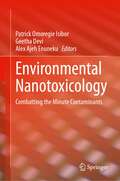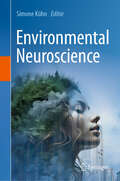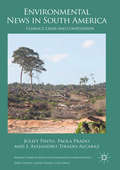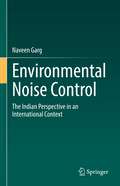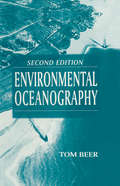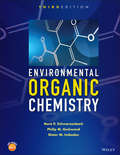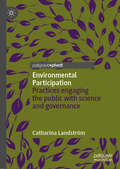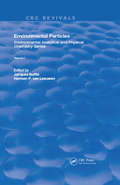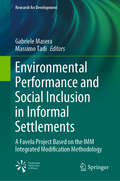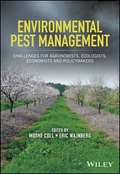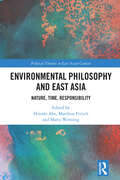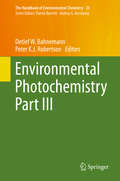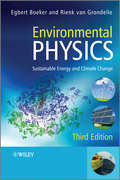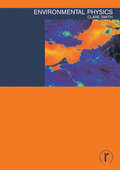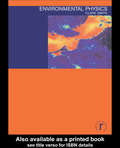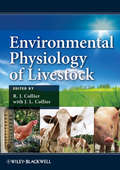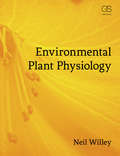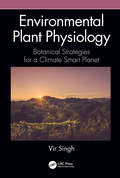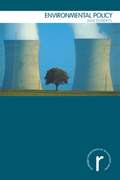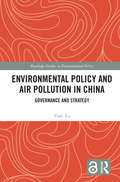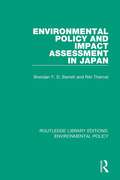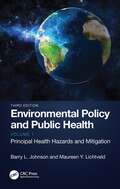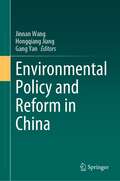- Table View
- List View
Environmental Nanotoxicology: Combatting the Minute Contaminants
by Patrick Omoregie Isibor Alex Ajeh Enuneku Geetha DeviEnvironmental Nanotoxicology: Combatting the Minute Contaminants is a comprehensive guide to the rapidly evolving field of nanotoxicology and its implications for environmental health and safety. This book results from the collaborative efforts of leading experts and researchers from diverse disciplines, aiming to thoroughly understand the interactions between nanomaterials and the environment and their potential impacts on the delicate balance of our ecosystems.Nanotechnology has witnessed remarkable innovations leading to the development of nanomaterials with novel properties and applications across various industries. Alongside these innovations, concerns have arisen about the potential risks that nanomaterials may pose to the environment and living organisms. This book addresses these concerns by comprehensively exploring the field's key concepts, principles, and methodologies. It includes case studies and offers insights into developing appropriate regulatoryframeworks and guidelines for the responsible use and disposal of nanomaterials. The book is a valuable resource for researchers and professionals working in nanotoxicology on the complex challenges posed by the intersection of nanomaterials and the environment. It is also an essential reference for students studying environmental science, toxicology, and nanotechnology.
Environmental Neuroscience
by Simone KühnThis important new book presents an introduction to Environmental Neuroscience, an emerging field devoted to the study of brain-mediated bidirectional relationships between organisms and their physical environments. Environmental Neuroscience offers a novel perspective in the human neurosciences, which have typically focused on the individual isolated from its natural habitat. The book presents the theoretical background of the field, discusses how the environment impacts humans and how humans impact the environment, explores the neuroscience of the built environment, and addresses special populations and presents different methodological approaches. Environmental Neuroscience bringing together the top authorities in the field, will appeal to neuroscientists and to a range of scholars from public health, urban studies, human geography, and architecture who are searching for guidance on what characterizes a health-promoting environment.
Environmental News in South America
by Juliet Pinto Paola Prado J. Alejandro Tirado-AlcarazCombining perspectives from media studies and political ecology, this book analyses socially constructed news regarding three environmental conflicts in South America. In recent decades, South American political administrations have tied national economies to neo-extractive development strategies, creating not only vulnerabilities to global commodity boom and bust pricing cycles, but also to conflict regarding environmental and cultural degradation from extraction activities. Environmental contestations among indigenous peoples, environmental and social NGOs, state actors, and extraction industries receive media attention, but how these disputes are covered has implications for understandings of media performance in democratizing nations. The authors examine three case studies of environmental contestation in a region that is simultaneously vulnerable to the effects of climate change, and yet has become once again dependent on commodity exportation to industrializing and industrialized nations for economic benefit and social development strategies.
Environmental Noise Control: The Indian Perspective in an International Context
by Naveen GargThis book provides a concise and up-to-date overview of environmental noise control issues, utilizing specific case studies from India to help explore noise mapping and monitoring, impact analysis, and policy, among other relevant topics. The book provides an extensive review of recent studies, including references, and describes the latest noise monitoring structures. It also addresses heretofore under-emphasized topics, including but not limited to acoustic metrology, Multi Attribute Decision Making (MADM) techniques, and sound insulation utilizing passive control strategies.
Environmental Oceanography: An Introduction To The Behaviour Of Coastal Waters (CRC Marine Science #11)
by Tom BeerThe second edition of Environmental Oceanography is the first textbook to link the needs of the coastal oceanographer and the environmental practitioner. The ever-increasing human impact on the environment, and particularly on the coastal zone, has led governments to carefully examine the environmental implications of development proposals. This book provides the background needed to undertake coastal oceanographic investigations and sets them in context by incorporating case studies and sample problems based on the author's experience as an environmental consultant.
Environmental Organic Chemistry
by Philip M. Gschwend Dieter M. Imboden René P. SchwarzenbachExamines in a pedagogical way all pertinent molecular and macroscopic processes that govern the distribution and fate of organic chemicals in the environment and provides simple modeling tools to quantitatively describe these processes and their interplay in a given environmental system Treats fundamental aspects of chemistry, physics, and mathematical modeling as applied to environmentally relevant problems, and gives a state of the art account of the field Teaches the reader how to relate the structure of a given chemical to its physical chemical properties and intrinsic reactivities Provides a holistic and teachable treatment of phase partitioning and transformation processes, as well as a more focused and tailor-made presentation of physical, mathematical, and modeling aspects that apply to environmental situations of concern Includes a large number of questions and problems allowing teachers to explore the depth of understanding of their students or allowing individuals who use the book for self-study to check their progress Provides a companion website, which includes solutions for all problems as well as a large compilation of physical constants and compound properties
Environmental Participation: Practices engaging the public with science and governance
by Catharina LandströmThis book introduces environmental participation as a distinct field comprising diverse practices. It presents examples of public participation specifically in environmental science, decision making and expertise. The first chapter introduces the science studies perspective and the key concepts that underpin the argument for approaching such a range of practices as a coherent field. The following three chapters explore a wide range of practical examples of how the public can participate in all three domains. Drawing on her experience with a variety of transdisciplinary projects Landström discusses topics including the coproduction of knowledge about flooding, community involvement with radioactive waste disposal and collaborative water quality modelling. She then goes on to cover citizen science and social movement expertise as environmental participation practices. The concluding chapter reflects on the challenges as well as future opportunities of environmental participation. This book is aimed at readers from a variety of academic and non-academic backgrounds and will be a great interest to social and natural scientists, students and practitioners.
Environmental Particles: Volume 1 (Routledge Revivals)
by Jacques Buffle Herman P. van LeeuwenFirst published in 1992, Environmental Particles describes properties, roles, and methods for the characterization of environmental particles in air, water, sediment, and soil. This book emphasizes modern methods for sampling, instrumental characterization methods, and physical/chemical principles for describing the properties and roles of particles in the environment (particularly their influence on the transport of toxic compounds). It will be an excellent reference source for environmental chemists and physicists, limnologists, oceanographers, air and soil scientists, analytical chemists, environmental engineers, scientists involved in environmental protection, and students.
Environmental Performance and Social Inclusion in Informal Settlements: A Favela Project Based on the IMM Integrated Modification Methodology (Research for Development)
by Gabriele Masera Massimo TadiThis book discusses the potential of a systemic and multidisciplinary design approach to improve urban quality, health, livability, and inclusiveness for people living in informal settlements. In most instances, attempts to address informal settlements lack an adequate assessment of their impact on the wider built environment and implementation of the UN’s Sustainable Development Goals. The Integrated Modification Methodology (IMM), introduced here, offers a systematic, multidisciplinary design tool encompassing several of the aspects that define the environmental performance of urban systems. The book also demonstrates the application of the methodology to an informal settlement, proving its potential to guide systemicurban transformations, also in urban areas lacking formal planning. The case study investigated is in the Rocinha favela in Rio de Janeiro, which ischaracterized by poor water quality, lack of drainage and sanitation systems, and very few green spaces. Based on a rigorous methodology, the process described here can also be applied in similar contexts around the world.
Environmental Pest Management: Challenges for Agronomists, Ecologists, Economists and Policymakers
by Eric Wajnberg Moshe CollA wide-ranging, interdisciplinary exploration of key topics that interrelate pest management, public health and the environment This book takes a unique, multidimensional approach to addressing the complex issues surrounding pest management activities and their impacts on the environment and human health, and environmental effects on plant protection practices. It features contributions by a distinguished group of authors from ten countries, representing an array of disciplines. They include plant protection scientists and officers, economists, agronomists, ecologists, environmental and public health scientists and government policymakers. Over the course of eighteen chapters, those experts share their insights into and analyses of an array of issues of vital concern to everyone with a professional interest in this important subject. The adverse effects of pest control have become a subject of great concern worldwide, and researchers and enlightened policymakers have at last begun to appreciate the impact of environmental factors on our ability to manage pest populations. Moreover, while issues such as pesticide toxicity have dominated the global conversation about pest management, economic and societal considerations have been largely neglected. Environmental Pest Management: Challenges for Agronomists, Ecologists, Economists and Policymakers is the first work to provide in-depth coverage of all of these pressing issues between the covers of one book. Offers a unique multi-dimensional perspective on the complex issues surrounding pest management activities and their effect on the environment and human health Addresses growing concerns about specific pest management strategies, including the use of transgenic crops and biological controls Analyses the influence of global processes, such as climate change, biological invasions and shifts in consumer demand, and ecosystem services and disservices on pest suppression efforts Explores public health concerns regarding biodiversity, pesticide use and food safety Identifies key economic drivers of pest suppression research, strategies and technologies Proposes new regulatory approaches to create sustainable and viable crop protection systems in the framework of agro-environmental schemes Offering a timely and comprehensively-unique treatment of pest management and its environmental impacts in a single, inter-disciplinary volume, this book is a valuable resource for scientists in an array of disciplines, as well as government officials and policymakers. Also, teachers of undergraduate and graduate level courses in a variety of fields are sure to find it a highly useful teaching resource.
Environmental Philosophy and East Asia: Nature, Time, Responsibility (Political Theories in East Asian Context)
by Matthias Fritsch Mario Wenning Hiroshi AbeThis book explores the contributions of East Asian traditions, particularly Buddhism and Daoism, to environmental philosophy in dialogue with European philosophy. It critically examines the conceptions of human responsibility toward nature and across time presented within these traditions.The volume rethinks human relationships to the natural world by focusing on three main themes: Daoist and Eurodaoist perspectives on nature, human responsibility toward nature, and Buddhist perspectives on life and nature. By way of discussing East Asian traditions and European thinkers, this collection reveals that the impact of humanity on the environment is shaped not only by distinctive modes of economic production, but also by cultural beliefs and practices. Representing a unique constellation of environmental and intercultural philosophy, the contributions present systematic approaches to the global need for cultivating environmental responsibility across cultures and generations to address the political, ethical, and aesthetic challenges arising from humanity’s transformative impact on the natural world.Presenting a critical re-evaluation of human relationships to the natural world in dialogue with East Asian traditions, this will be a valuable resource for students and scholars of Philosophy, Environmental Studies and Asian Studies.
Environmental Photochemistry Part III
by Detlef W. Bahnemann Peter K. J. RobertsonThis volume builds on the previous two editions, Environmental Photochemistry Part I and Part II, which reflect the diverse range of activities in this highly dynamic research field. The chapters cover fundamental topics, from photocatalyst materials, surface-modified materials, reaction kinetics and reactor modelling, to translational research activities on chemical synthesis, energy conversion and water treatment. The applications of the new generation of LED irradiation sources and spectroscopic methods for elucidating reaction pathways are also covered in detail. This new volume maintains the ethos of the previous editions by further contributing to readers' understanding of photochemical and photocatalytic processes for environmental applications.
Environmental Physics
by Rienk Van Grondelle Egbert BoekerThis thoroughly revised and updated third edition focuses on the utilization of sustainable energy and mitigating climate change, serving as an introduction to physics in the context of societal problems. A distinguishing feature of the text is the discussion of spectroscopy and spectroscopic methods as a crucial means to quantitatively analyze and monitor the condition of the environment, the factors determining climate change, and all aspects of energy conversion. This textbook will be invaluable to students in physics and related subjects, and supplementary materials are available on a companion website.
Environmental Physics (Routledge Introductions To Environment: Environmental Science Ser.)
by Clare SmithFirst Published in 2002. Environmental Physics is a comprehensive introduction to the physical concepts underlying environmental science. The importance and relevance of physics is emphasised by its application to real environmental problems with a wide range of case studies. Applications included cover energy use and production, global climate, the physics of living things, radioactivity, environmental remote sensing, noise pollution and the physics of the Earth. The book makes the subject accessible to those with little physics background, keeping mathematical treatment straightforward. The text is lively and informative, and is supplemented by numerous illustrations, photos, tables of useful data, and a glossary of key terms.
Environmental Physics (Routledge Introductions to Environment: Environmental Science)
by Clare SmithEnvironmental Physics is a comprehensive introduction to the physical concepts underlying environmental science. The importance and relevance of physics is emphasised by its application to real environmental problems with a wide range of case studies. Applications included cover energy use and production, global climate, the physics of living things, radioactivity, environmental remote sensing, noise pollution and the physics of the Earth. The book makes the subject accessible to those with little physics background, keeping mathematical treatment straightforward. The text is lively and informative, and is supplemented by numerous illustrations, photos, tables of useful data, and a glossary of key terms.
Environmental Physiology of Livestock
by R. J. CollierEnvironmental stress is one of the most significant factors affecting livestock performance and health, and it is only expected to increase with effects of global warming. Environmental Physiology of Livestock brings together the latest research on environmental physiology, summarizing progress in the field and providing directions for future research. Recent developments in estimating heat stress loads are discussed, as well as key studies in metabolism, reproduction, and genetic expressions. Environmental Physiology of Livestock begins with a survey of current heat indexing tools, highlighting recent discoveries in animal physiology, changes in productivity levels, and new technologies available to better estimate stress response. Using this synopsis as a point of orientation, later chapters hone in on major effects of heat stress, including changing metabolic pathways and nutrient requirements, endocrine regulation of acclimation to environmental stress, and reduced reproductive performance. The text concludes with a thorough discussion of environmental effects on gene expressions, providing important insight for future breeding practices. Environmental Physiology of Livestock is a globally contributed volume and a key resource for animal science researchers, geneticists, and breeders.
Environmental Plant Physiology
by Neil WilleyEnvironmental Plant Physiology focuses on the physiology of plant-environment interactions, revealing plants as the key terrestrial intersection of the biosphere, atmosphere, hydrosphere and geosphere. It provides a contemporary understanding of the topic by focusing on some of humankind's fundamental biological, agricultural and environmental challenges. Its chapters identify thirteen key environmental variables, grouping them into resources, stressors and pollutants, and leading the reader through how they challenge plants and how plants respond at molecular, physiological, whole plant and ecological levels. The importance of taking account of spatial and temporal dimensions of environmental change in order to understand plant function is emphasised. The book uses a mixture of ecological, environmental and agricultural examples throughout in order to provide a holistic view of the topic suitable for a contemporary student audience. Each chapter uses a novel stress response hierarchy to integrate plant responses across spatial and temporal scales in an easily digestible framework.
Environmental Plant Physiology: Botanical Strategies for a Climate Smart Planet
by Vir SinghEnvironmental Plant Physiology provides a stupendous knowledge source for undergraduate and graduate students and their teachers in many inter-related disciplines, like life sciences, agricultural sciences, environmental sciences, ecology, and climatology. Further, this book can also be of vital importance for policy makers and organizations dealing with climate related issues and committed to the cause of the Earth. This book can be instrumental in formulating strategies that can lead us to a climate smart planet. Features: Ecological basis of environmental plant physiology. Energy, nutrient, water, temperature, allelochemical and altitude relations of plants. Stress physiology of plants. Climate change effects on plant physiology. Plants’ adaptations to the changing climate. Evolving botanical strategies for a climate smart planet.
Environmental Policy (Routledge Introductions to Environment: Environment and Society Texts)
by Jane RobertsWithin the overall context of sustainable development Environmental Policy discusses the opportunities and constraints that environmental systems place upon the operation of human systems. It suggests environmental policy is a potential way to modify the operation of human systems so that they function within environmental constraints. Key social scientific concepts (political, social and economic) are used to explain the background for the formulation and implementation of environmental policy.Environmental problems, the role of humans in creating them, sustainable development and how this concept relates to environmental policy are all introduced. The book then considers environmental policy formulation, implementation and evaluation, within three specific contexts: the firm, the nation state and at the international level. It also reviews the place of economics, science and technology in environmental policy.Detailed case-studies, drawn from a range of international examples, are used throughout to illustrate issues such as global warming, international trade, tourism and the human rights of indigenous peoples. It is well illustrated and includes end of chapter summaries and further reading.
Environmental Policy and Air Pollution in China: Governance and Strategy (Routledge Studies in Environmental Policy)
by Yuan XuThis book systematically analyzes how and why China has expectedly lost and then surprisingly gained ground in the quest to solve the complicated environmental problem of air pollution over the past two decades. Yuan Xu shines a light on how China’s sulfur dioxide emissions rose quickly in tandem with rapid economic growth but then dropped to a level not seen for at least four decades. Despite this favorable mitigation outcome, Xu details how this stemmed from a litany of policy stumbles within the Chinese context of no democracy and a lack of sound rule of law. Throughout this book, the author examines China’s environmental governance and strategy and how they shape environmental policy. The chapters weave together a goal-centered governance model that China has adopted of centralized goal setting, decentralized goal attainment, decentralized policy making and implementation. Xu concludes that this model provides compelling evidence that China’s worst environmental years reside in the past. This book will be of great interest to students and scholars of Chinese environmental policy and governance, air pollution, climate change and sustainable development, as well as practitioners and policy makers working in these fields.
Environmental Policy and Impact Assessment in Japan (Routledge Library Editions: Environmental Policy #2)
by Riki Therivel Brendan F. BarrettFirst published in 1991. Japanese attitudes to pollution and environmental protection were distinctly equivocal. The Japanese are a nature-loving people, yet they are responsible for widespread environmental destruction; Japan has some of the world’s strictest environmental quality standards, but the country also has some of the world’s most environmentally damaged areas. In this book the authors present a broad and detailed analysis of policy and process in Japan in the late twentieth century. Brendan Barrett and Riki Therivel, who both have extensive research experience in Japan, describe interest group participation in Japan’s environmental policy-making and give an historical review of the relationship between economic growth and environmental problems. They look at the framework for environmental policy-making and outline the system for environmental management. This is complemented by a discussion of Environmental Impact Assessment, and by live case studies of the practical realities of EIA in Japan. With environmental problems reaching global proportions, countries all over the world have much to learn from the experience of Japan, and the book will be extremely useful to national government officials, to local planning officers responsible for EIA, and to environmental consultants working for commercial and industrial companies. It will also be essential reading for students of geography, environmental studies, Japanese studies and planning economics.
Environmental Policy and Public Health
by Barry L. Johnson Maureen Y. LichtveldAs with the first edition, this second edition describes how environmental health policies are developed, the statutes and other policies that have evolved to address public health concerns associated with specific environmental hazards, and the public health foundations of the policies. It lays out policies for what is considered the major environmental physical hazards to human health. Specifically, the authors describe hazards from air, water, food, hazardous substances, and wastes. To this list the authors have added the additional concerns from climate change, tobacco products, genetically-modified organisms, environment-related diseases, energy production, biodiversity and species endangerment, and the built environment. And as with the first edition, histories of policymaking for specific environmental hazards are portrayed. This edition differs from its antecedent in three significant themes. Global perspectives are added to chapters that describe specific environmental hazards, e.g., air pollution policies in China and India. Also there is the material on the consequences of environmental hazards on both human and ecosystem health. Additionally readers are provided with information about interventions that policymakers and individuals can consider in mitigating or preventing specific environmental hazards.
Environmental Policy and Public Health: Emerging Health Hazards and Mitigation, Volume 2
by Barry L. Johnson Maureen Y. LichtveldWritten by environmental health experts with long teaching and professional careers in policy and public health, the third edition of Environmental Policy and Public Health comprises two volumes, addressing key physical hazards in the environment that impact public health. The first volume on Principal Health Hazards and Mitigation is complemented by the second volume, Emerging Health Hazards and Mitigation. Volume 2 discusses emerging health hazards and mitigation including environment-related infectious diseases, COVID-19 pandemic, social justice, and drugs and public health. New in this volume are a chapter on firearms violence as a public health hazard, a chapter on transportation and how built environments can affect human health and social well-being, and a chapter on noise and light pollution. As human populations increase and technology adds more devices to daily use that generate noise and light, adverse human and ecological health effects have become recognizable and require time-sensitive policy actions to mitigate and where possible prevent adverse health effects. Each chapter explains with great clarity how new environmental health issues are translated into public health policies. The volume concludes with case studies and practice questions to facilitate interactive learning for upper-level undergraduate and graduate students taking courses in public health and environmental sciences. The case studies and practice questions allow for a diverse portfolio of in-person and hybrid pedagogical strategies and tools at the fingertips of faculty who not only teach policy courses but whose course topics have policy relevance, such as climate and health.
Environmental Policy and Public Health: Principal Health Hazards and Mitigation, Volume 1
by Barry L. Johnson Maureen Y. LichtveldWritten by environmental health experts with long teaching and professional careers in policy and public health, the third edition of Environmental Policy and Public Health comprises two volumes addressing key physical hazards in the environment that impact public health. The first volume on Principal Health Hazards and Mitigation is complemented by the second volume, Emerging Health Hazards and Mitigation. The health of the environment is inextricably linked to that of people. Thoroughly updated, Volume 1 describes how the quality of air, water, and food is threatened by the presence of toxic substances and explains why climate change is a global health priority already impacting human health and the environment. The mitigations discussed in this volume are twofold: policies that are intended for control of specific hazards and suggested hazard interventions. The role of policy in addressing each of these key environmental health areas is extensively discussed in this volume as well. Each chapter explains step by step how new environmental health issues are translated into public health policies and concludes with practice questions to facilitate interactive learning for upper-level undergraduate and graduate students taking courses in public health and environmental sciences. The step-by step approach, as well as the case studies and practice questions, allow for a diverse portfolio of in-person and hybrid pedagogical strategies and tools at the fingertips of faculty who not only teach policy courses, but whose course topics, such as climate and health, have policy relevance.
Environmental Policy and Reform in China
by Jinnan Wang Hongqiang Jiang Gang YanThe book is the collection of the latest research results from Chinese Academy of Environmental Planning in environmental policy and reform during the past years, mainly related to ecological compensation, the emission trading, the environment audit, carbon tax, environment friendly city, environmental health, economic policy in medical waste, scattered coal treatment subsidies, environmental policy efficiency analysis, environmental industry statistics, environmental performance evaluation, green fiscal and taxation policy, etc., presenting the latest achievements, developments and research trends in this field.
